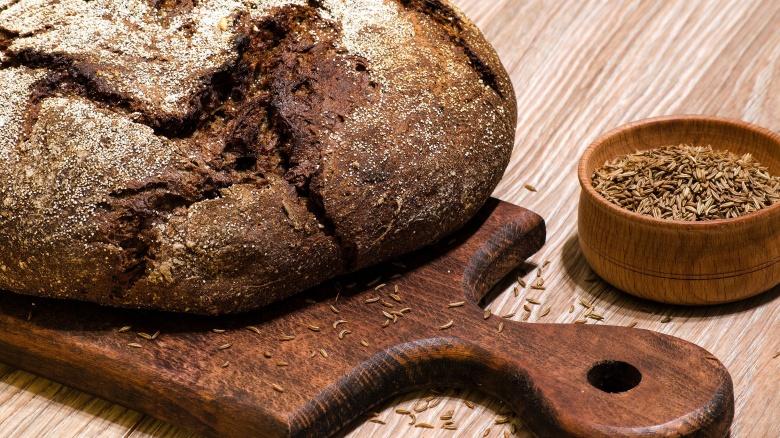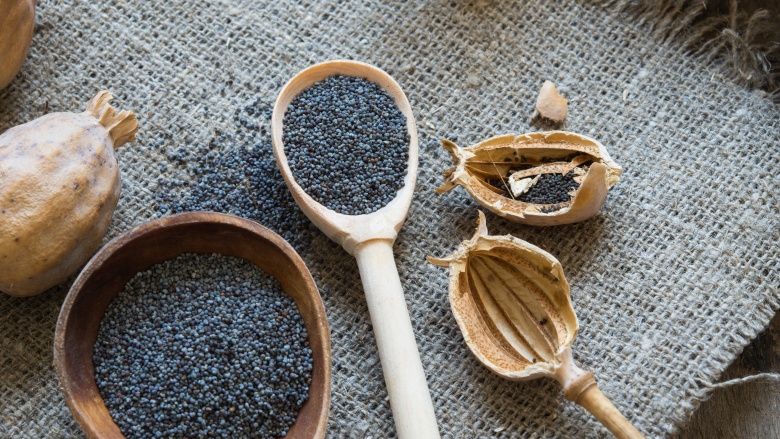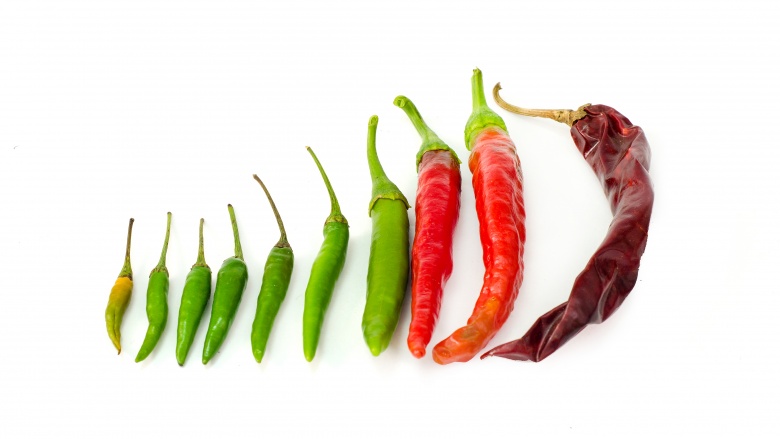Foods That Actually Mess With Your Head
Since the dawn of time, people have been seeking ways to alter their consciousness. Prehistoric man was hip to the knowledge that some foods and herbs were psychoactive, meaning they could alter and influence the mind. From the Native Americans' use of peyote to South Americans munching on coca leaves, history is full of trippy stories of nature's wild and wacky psychoactive substances.
By now, we are all familiar with the effects that common stimulants and depressants have on the body, from everyday indulgences like caffeine and alcohol, to legal and illegal substances like opiates, nicotine, and marijuana. But what about the very foods that we eat on a daily basis — are they as innocent as you think? Have you ever gotten a rush from eating a particularly spicy hot sauce? Feeling a little woozy after eating a few too many snickerdoodles? Are there foods that actually mess with your head?
Nutmeg
You may enjoy it on top of your venti latte, but nutmeg has a long and storied history of use that far surpasses its inclusion in a jar of pumpkin spice. A treasure of the Spice Islands, nutmeg was traded as a medicinal elixir, along with the spice mace, which comes from the same fruit. The claims of nutmeg's medicinal properties were far reaching. Nutmeg was supposedly an aphrodisiac, could treat anxiety or depression, and was even believed to heal ailments like the common cold and the bubonic plague. On a less fun note, nutmeg also has a history of use as an abortifacient. But perhaps no use is quite as infamous as its use as a recreational drug.
Nutmeg contains high levels of myristicin, a psychoactive chemical that is synthesized and used as an ingredient in stronger street drugs. In high enough doses, nutmeg is a type of hallucinogen known as a deliriant, causing hallucinogenic delusions and euphoria, accompanied by nasty side effects like vomiting, dry mouth, diarrhea, dizziness, slurred speech, loss of coordination, and shortness of breath. Nutmeg use also has a reputation of producing a horrendous hangover feeling. The harshness of nutmeg's side effects make it unappealing to the masses. The onset of nutmeg's effects can take up to six hours after ingestion, which can lead to a user taking more than is needed seeking a nutmeg high, only to wind up in the emergency room, with a few cases even resulting in death. Needless to say, we don't recommend you try this at home.
Worried your next pumpkin spice cappuccino is going to land you in the psych ward? Don't fret, nutmeg is perfectly safe in small amounts.
Rye bread
It is quite possible that no other food has had such a profound impact on world history as rye bread.
When some cereal grains, most commonly rye, are kept in moist conditions, they can develop a fungal disease known as ergot. Consumption of the infected grain can lead to rye poisoning, or ergotism, which causes symptoms such as burning pain, screaming fits, hallucinations, convulsions, delusions, miscarriage, and even gangrene. Rye bread was a staple among the poor in the Middle Ages, and the symptoms of ergotism were first recorded in 857 A.D. The distressing symptoms of the infection earned it the name Holy Fire, and later Saint Anthony's Fire, named for the patron saint of the many hospitals erected to care for ergotism's victims.
It is believed that ergot poisoning can be blamed for the susceptibility of the weakened Franks by the invading Vikings (who did not eat rye,) a victory that split the Holy Roman Empire, influencing the borders of Germany and France. Ergotism may have even lent a hand to the success of the bubonic plague, which killed at least a third of Europe's population. Incidents of the plague surged in areas with large grain stores, where ergotism is thought to have weakened the immune systems of the masses. It has also been suggested that victims of ergotism in the Dark Ages through the Salem Witch Trials were charged with witchcraft when they exhibited common ergotism symptoms like convulsions and hallucinations — behavior that suggested they had been possessed by evil spirits.
Due to modern production methods, ergotism is now extremely rare, so you don't need to keep yourself from that pastrami on rye you've been craving. Useful medications have actually been created from ergot. Ergotamine (for migraines), ergonovine (for postpartum bleeding), and a one-time treatment for psychiatric disorders that you may have heard of — LSD.
Kava
Kava, sometimes called Kava Kava, is a shrub native to Polynesia. It has been consumed and used for thousands of years in the South Pacific as part of rituals and ceremonies, but also recreationally. A scientifically backed anxiolytic (anti-anxiety remedy), kava is a psychoactive sedative that relaxes the user and reduces stress, though overuse can cause a drunken sort of stupor. Kava consumption is popular as an alternative to alcohol or illegal substances, and while controversial, some claim to use kava as a recovery aid for substance and alcohol abuse.
Typically consumed in tea form, kava has suffered a backlash in recent years due to its association with liver disease, though some argue that this is due to the use of cheaper, "ignoble" kava, which produces far harsher effects on the body than its "noble" counterpart. Health implications have caused kava to be banned or restricted in several countries, including Poland and Australia. Kava use is legal in the U.S. in both tea and supplement form, with kava bars popping up across the country, though few policies are in place to ensure the quality of the kava they offer. Looking forward to giving this legal psychoactive a try yourself? A couple of warnings first. Excessive use of kava can lead to a nasty, scaly, fish-like skin rash that clears up once consumption decreases. Also, kava can have some even nastier side effects when mixed with alcohol or prescription medications (particularly sleep aids, anti-anxiety meds, and mood stabilizers), so do your homework before you order a kava margarita.
Garlic
Long touted as a health food as well as a supplement, garlic has been shown in studies to possess medicinal properties that can help control illnesses like the common cold, boost bone health, reduce blood pressure, and lower cholesterol. Seems like there is nothing about garlic not to love. Right? Not so fast.
Garlic has a different reputation among raw foodists, practitioners of Eastern medicine and religions, and even airline pilots, and it's one that might have you shying away from that third slice of garlic bread. The belief is that garlic, and some other members of the allium family, are in fact toxic to brain cells, causing a disturbance in the brain. Garlic was shunned by the Taoists, who believed its consumption led to aggressiveness. In Ayurveda, garlic is regarded as a "rajasic and tamasic" food, classes of foods thought to promote ignorance and be detrimental to meditation. Buddhists label garlic as a "hun" or non-vegetarian food and believe that the offensive bodily odors it creates rob joy from those around them.
Garlic's opponents point to the findings of Bob Beck, who preached that garlic is a poison that affects the mind and concentration, often citing an anecdotal story of a flight surgeon from the 1950s who would instruct pilots in training to avoid garlic for 72 hours prior to a flight to avoid lags in reaction time. Beck was often accused of quackery due to his invention of the controversial "Bob Beck Protocol," which he claimed could cure all manner of disease with electric micropulse therapy.
What's our take? Garlic definitely messes with your body, but current scientific literature suggests it's in a good way. But we recommend avoiding it on days you plan on any heavy necking sessions, unless it's with a vampire.
Fish
Believe it or not, fish can get you high. Well, some fish can, like coral grouper, sea chub, and rabbitfish. But most often, it's the Sarpa salpa species of Mediterranean sea bream known as salema porgy. Called the "dream fish" in Arabic, Sarpa salpa is reported to produce symptoms similar to LSD. Ichthyoallyeinotoxism, the condition associated with consuming the hallucinogenic fish, is a form of food poisoning that can cause stomach upset, dizziness, visual and auditory hallucinations, nightmares, and loss of equilibrium. Ichthyoallyeinotoxism still remains a bit of a mystery to scientists, but it is suspected that the carrier fish pick up the offending toxin from the particular algae they consume. It's possible the ancient Romans were hip to the sea bream vibe and would use it as a recreational drug. Nowadays, accidental poisonings are extremely rare, though cases made headlines as recently as 2006.
Poppy seeds
Did you know that you may have morphine in your kitchen cupboard right now? Though poppies come in many different varieties, it is the opium poppy that is the base for making legal and illegal substances like morphine, codeine, heroin, and a myriad of prescription opiates. In some cases, it is the same exact type of poppy that provides the seeds used in baking. So it stands to reason that some people would get the idea to try and get high with them.
With poppy seeds, however, the devil really is in the dose. Although Mythbusters did prove the old fable to be true about poppy seed consumption causing a drug test to show as positive for opiate use, it would take an enormous amount of poppy seed bagels to produce a psychoactive effect in a person. One danger lurks in the use of poppy seeds in poppy seed tea, a self-prescribed treatment among some in opioid recovery, as well as with teens seeking a supermarket high.
One store recently reported needing to remove poppy seeds from the shelves due to theft. The home-brewed tea is made using pounds of poppy seeds, and therein lies the risk. It's impossible to gauge the potency of a particular batch of seeds, which can vary widely depending on the country of origin. Spanish poppy seeds ring in the highest at .025 percent morphine by weight, but other varieties can contain up to 100 times less. Poppy seed tea consumption can even result in death. Our advice? Stick to a lemon poppy seed muffin, and skip the tea.
Chili peppers
If salty, bitter, sweet, sour, and (newly discovered) umami are the commonly agreed-upon five tastes perceived by our human tongues, where exactly does spicy fit in? Would you believe that spicy is not a taste at all, but actually a trick of the brain?
The sensation from biting into a hot chili that we suffer through, (or luxuriate in, if you are a chili-phile), is due to a chili pepper's heat-inducing ingredient, capsaicin. Capsaicin, when it hits the tongue, begins a fiery dance with a protein called TRPV1, a nerve cell pain-receptor whose chief role is to alert the brain to dangerous rises in body temperature or scalding heat. TRPV1 can't tell the difference between actual heat and the effects of capsaicin, and the brain answers its obedient little receptor cells by inciting a round of sweating, eye-tearing, and nose-running, followed by sending waves of pain-relieving endorphins and relaxing dopamine through the body. Chili aficionados compare this rush to a "runner's high." While chili peppers may not technically be addictive, "mouth-surfers" will tell you that the craving is very real and intensifies as tolerance to the effects of capsaicin is built, which may explain why chili thrill-seekers strive to sample chilis that score higher and higher on the Scoville scale.
Chocolate
If you are a chocolate lover (and hey, who isn't?), it should come as no great shock to you that science has confirmed what we have known all along: chocolate really does make you feel good. Loaded with feel-good chemicals like caffeine and theobromine (a mild stimulant), chocolate also contains phenylethylamine, a cousin to amphetamines that releases pleasurable endorphins in the body, akin to the feeling of being in love, which explains chocolate's use as an aphrodisiac over the centuries. If that wasn't enough to make you crazy for cocoa puffs, there's more. Chocolate has also been discovered to contain anandamide, which acts as a "bliss receptor" in the brain, according to the Neurosciences Institute in San Diego.
And since chocolate truly is the gift that keeps on giving, there's even more chocolatey goodness. Did you know that eating specially engineered chocolates might make you smarter? Of course you did, if you have been eating them at least once a week. The Washington Post reports on a study in which participants who consumed flavonol-rich chocolate at least once a week exhibited "superior visual-spatial memory and [organization], working memory, scanning and tracking, [and] abstract reasoning."
So keep on munching away on your favorite, high-quality chocolate treats. We just can't recommend that you snort it.
Sugar
Sugar. Unless you are a hard-core Ketogenic or Paleo dieter, there is a chance that you adore sugar and enjoy it daily. Whether it's in a bowl of pasta, a package of cookies, or a carton of organic Greek yogurt, sugar in both its natural and added states provides our bodies with quick access to the glucose that our brains rely on for energy. But, as we have learned from sugar's links to heart disease, diabetes, high blood pressure, premature aging, and obesity, it is obviously possible to get way too much of a good thing. So why do we have such a tendency to overconsume this sweetly disguised demon? Is it possible that we are all addicted to sugar?
Similar to the way other drugs, like cocaine and heroin, activate the mesolimbic pathway, or reward center of the brain, sugar also triggers the release of feel-good dopamine. And similar to the overuse of those drugs, our brains eventually become desensitized to the effects, requiring higher and higher doses to produce the same sugar-induced dopamine high, lest we suffer a depressing withdrawal. These findings, which in some cases have even shown rats preferring sugar to cocaine, are slowly debunking the previously held scientific belief that the body cannot be addicted to foods. Making the case for the reality that sugar is addictive, researchers in Australia have shown that prescription medications used for the treatment of addictions can be utilized for treating addiction to sugar. The journal Nature, in 2012, even suggested that the deleterious effects of sugar should require it to be regulated in the same ways we regulate nicotine and alcohol.
In 2015, the FDA did finally place a cap on recommended sugar consumption: 50 grams per day, or about one can of soda. The World Health Organization recommends we eat only half that. But don't worry, nobody is planning to come and confiscate your Skittles just yet.









